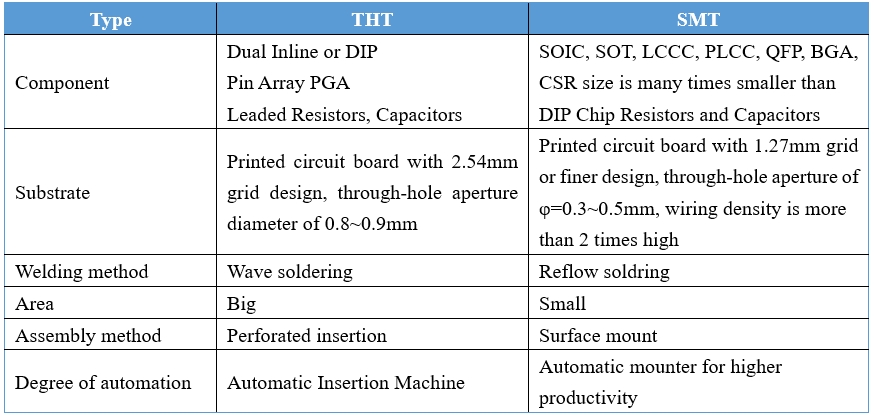Comparison of Surface Mount and Through-Hole Technologies_Shenzhen Fitech

Comparison of Surface Mount and Through-Hole Technologies_Shenzhen Fitech
Surface mount technology (SMT) and through-hole insertion technology (THT) are the two main methods of mounting electronic components on printed circuit boards (PCBs). Although they both play an important role in electronics manufacturing, there are significant differences in technology and applications.
Surface Mount Technology (SMT): In a narrow sense, SMT is the process of pasting surface components onto a PCB and realizing the interconnection of electronic components through integral heating. However, in a broader sense, it includes a number of aspects, such as chip components, surface assembled circuit boards and their process design, surface assembly equipment (such as printers, dispensers, reflow soldering equipment), as well as assembly materials (such as solder paste, flux) and so on.
Through-Hole Technology (THT): the use of THC (through-hole mounted components) and THD (through-hole mounted devices) to hand soldering, dip soldering and wave soldering and other ways to complete the installation on the PCB and welding of a traditional installation process technology. Through-hole insertion technology requires more space on the PCB design because the components need to penetrate the board, which limits the compactness of the design.

Figure 1. SMT board (left) vs. THT board (right)
Difference between SMT and THT process
The fundamental difference between SMT and THT is between "paste" and "insert". Surface mount technology (SMT) using no lead or short lead components, components mounted on the surface of the PCB pad; and through-hole insertion technology (THT) is to rely on the metallization of the printed circuit board to fix the position of the holes, and will be inserted into the long lead components PCB pad holes and soft brazing soldering.
The SMT process pre-solder (solder paste) coated on the pads, mounted components after heating to complete the soldering process, components and solder joints on the same side of the PCB; while the THT process is through the wave soldering machine using the molten solder flow, to achieve the heating and soldering, components and solder joints were on both sides of the PCB.
Table 1. Comparison of SMT and THT processes

Advantages of the SMT process
1. High assembly density. Chip components occupy much less area and mass than traditional perforated components, and the more compact layout improves component integration.
2. High reliability. Chip components are small and light, so the shock resistance is strong; the use of automated production, mounting and welding reliability is high, the rate of defective solder joints is small.
3. Good high-frequency characteristics. Leadless devices reduce the impact of parasitic inductance and parasitic capacitance, improving the high frequency characteristics of the circuit. 4.
4. simplify the process. SMT technology simplifies the production process of electronic products, reduce production costs and improve production efficiency.
In practice, sometimes both SMT and THT technologies are used to meet the needs of different components and circuit board designs. For example, THT technology may be chosen for large components or parts with high reliability requirements, while SMT technology may be chosen for small components and high-density integration. This hybrid approach can fully utilize the advantages of both technologies to achieve more flexible and efficient electronics manufacturing.

















 Back to list
Back to list



